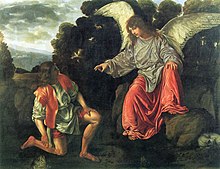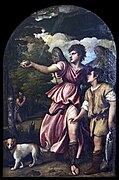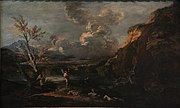Tobias and the Angel

Tobias and the Angel is the traditional title of depictions in art of a scene from the Book of Tobit in which Tobias, son of Tobit, travels with an angel called Raphael without realising he is an angel (5.5–6) and is then instructed by Raphael what to do with a giant fish he catches (6.2–9). The Book of Tobit is accepted by Catholic and Orthodox Christians as part of the biblical canon, but not by Judaism or most Protestants, the latter including it in the Apocrypha. The angel is regarded in Christianity as the Archangel Raphael.
Depictions usually show Raphael and a much smaller Tobias walking through a landscape, accompanied by Tobias's dog.[1] Tobias is usually carrying a fish (or two), often tied up with string, or a container for the fishes organs that will later cure his father. Raphael usually has large wings, which we must suppose are invisible to Tobias, as in the story he remains unaware his companion is an angel.

An alternative depiction, somewhat less common, shows Tobias with the very large fish he catches in the River Tigris. Typically Tobias is on the ground, sometimes in the water, and Raphael stands behind him, encouraging him to catch it. The fish Tobias carries in the travelling depictions are much more normally sized, and like the dog and Raphael's wings, serve as attributes to identify the subject.[2]
Dogs are unusual in Christian religious art, but the New Testament subject of the Exorcism of the Syrophoenician woman's daughter and the Old Testament one of Tobias and the Angel are exceptions, as they are mentioned in the texts, and depictions often include them. Although the dog in the Biblical account is presumably given to Tobias by his father to provide security as he travels carrying a significant amount of silver, artists tend to show very small dogs, with a long coat of hair that covers deficiencies in drawing them. Artists become noticeably more competent in this as the Renaissance progresses.
History[edit]
The scene was uncommon until about 1450, when it became very popular in northern Italy, especially Florence. This popularity lasted for about a century; small figures of Tobias and Raphael sometimes appear in the landscape backgrounds of more central religious scenes, such as a Virgin and Child by Lorenzo di Credi in the National Gallery.[3] Ernst Gombrich noted that Florentine depictions were "concentrated" between 1425 and 1475.[4] These, for which the version by the Pollaiuolo brothers perhaps provided the prototype, usually show a very richly dressed young teenager and a very small white dog.[5] In Vasari's time this hung in the very prominent location of the Orsanmichele.
The scene is the main narrative one to include Raphael, and the popularity is usually explained by an increase in devotion to him at this time, encouraged by confraternities associated with him.[6]
In the 17th century it had a second life as a device to turn a Baroque landscape into a more prestigous history painting by adding small figures.
Paintings[edit]
-
Filippino Lippi, Three Angels and Young Tobias (c. 1485)
-
Madonna of the Umbrella, Girolamo dai Libri, 1530s
-
Titian, Tobias and the Angel (c. 1540–1545)
-
Denis van Alsloot and Hendrik de Clerck, Landscape with Tobias and the Angel (17th century)
- Tobit with the Angel by Gerbrand van den Eeckhout
- Tobias and the Angel (1875) by Evelyn De Morgan
Other[edit]
-
Gothic corner, Doge's Palace, Venice
-
Andrea della Robbia, c. 1475, part of a glazed terracotta tabernacle
-
Engraving from the Otto prints, Florence, around 1475
-
Stained glass, Netherlands, c. 1500
-
Group of two limewood sculptures carved in 1516 by Veit Stoss, now in the Germanisches Nationalmuseum in Nuremberg.[7]
-
Silver plaquette by Matthäus Merian the Elder, 1627-1650
-
Wenceslaus Hollar, Tobias and the Angel, copying a painting by Adam Elsheimer
-
Bible illustration by Gustave Doré, 1866
- Tobias and the Angel by Hercules Seghers
Literature and theatre[edit]
- Tobias and the Angel (1930), play by James Bridie (1888–1951)
- Tobias and the Angel (opera) (1999), community opera
- Tobias and the Angel, 1975 novel by Frank Yerby
Notes[edit]
- ^ Brown
- ^ Brown, 140
- ^ Davies, 303 (NG 593)
- ^ Brown
- ^ Davies, 556
- ^ National Gallery page
- ^ "Catalogue entry" (in German). Retrieved 20 November 2020.
References[edit]
- Brown, David Alan et al., Bellini, Giorgione, Titian, and the Renaissance of Venetian Painting, 140, 2006, National Gallery of Art, ISBN 9780300116779, 0300116772, google books
- Davies, Martin, The Earlier Italian Schools, National Gallery Catalogues, 1961, reprinted 1986, ISBN 0901791296
External links[edit]
 Media related to Tobias and the Angel at Wikimedia Commons
Media related to Tobias and the Angel at Wikimedia Commons














![Group of two limewood sculptures carved in 1516 by Veit Stoss, now in the Germanisches Nationalmuseum in Nuremberg.[7]](http://upload.wikimedia.org/wikipedia/commons/thumb/4/40/GNM-Veit-Stoss-Raphael-Tobias.jpg/159px-GNM-Veit-Stoss-Raphael-Tobias.jpg)



